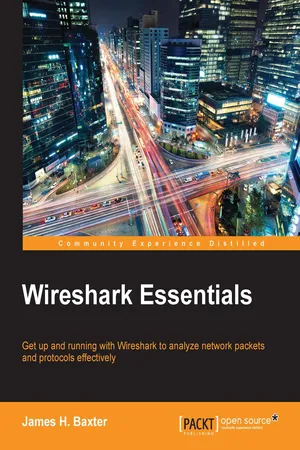![]()
![]()
Table of Contents
Wireshark Essentials
Credits
About the Author
About the Reviewers
www.PacktPub.com
Support files, eBooks, discount offers, and more
Why subscribe?
Free access for Packt account holders
Preface
What this book covers
What you need for this book
Who this book is for
Conventions
Reader feedback
Customer support
Errata
Piracy
Questions
1. Getting Acquainted with Wireshark
Installing Wireshark
Installing Wireshark on Windows
Installing Wireshark on Mac OS X
Installing Wireshark on Linux/Unix
Performing your first packet capture
Selecting a network interface
Performing a packet capture
Wireshark user interface essentials
Filtering out the noise
Applying a display filter
Saving the packet trace
Summary
2. Networking for Packet Analysts
The OSI model – why it matters
Understanding network protocols
The seven OSI layers
Layer 1 – the physical layer
Layer 2 – the data-link layer
Layer 3 – the network layer
Internet Protocol
Address Resolution Protocol
Layer 4 – the transport layer
User Datagram Protocol
Transmission Control Protocol
Layer 5 – the session layer
Layer 6 – the presentation layer
Layer 7 – the application layer
Encapsulation
IP networks and subnets
Switching and routing packets
Ethernet frames and switches
IP addresses and routers
WAN links
Wireless networking
Summary
3. Capturing All the Right Packets
Picking the best capture point
User location
Server location
Other capture locations
Mid-network captures
Both sides of specialized network devices
Test Access Ports and switch port mirroring
Test Access Port
Switch port mirroring
Capturing packets on high traffic rate links
Capturing interfaces, filters, and options
Selecting the correct network interface
Using capture filters
Configuring capture filters
Capture options
Capturing filenames and locations
Multiple file options
Ring buffer
Stop capture options
Display options
Name resolution options
Verifying a good capture
Saving the bulk capture file
Isolating conversations of interest
Using the Conversations window
The Ethernet tab
The TCP and UDP tabs
The WLAN tab
Wireshark display filters
The Display Filter window
The display filter syntax
Typing in a display filter
Display filters from a Conversations or Endpoints window
Filter Expression Buttons
Using the Expressions window button
Right-click menus on specific packet fields
Following TCP/UDP/SSL streams
Marking and ignoring packets
Saving the filtered traffic
Summary
4. Configuring Wireshark
Working with packet timestamps
How Wireshark saves timestamps
Wireshark time display options
Adding a time column
Conversation versus displayed packet time options
Choosing the best Wireshark time display option
Using the Time Reference option
Colorization and coloring rules
Packet colorization
Wireshark preferences
Wireshark profiles
Creating a Wireshark profile
Selecting a Wireshark profile
Summary
5. Network Protocols
The OSI and DARPA reference models
Network layer protocols
Wireshark IPv4 filters
Wireshark ARP filters
Internet Group Management Protocol
Wireshark IGMP filters
Internet Control Message Protocol
ICMP pings
ICMP traceroutes
ICMP control message types
ICMP redirects
Wireshark ICMP filters
Internet Protocol Version 6
IPv6 addressing
IPv6 address types
IPv6 header fields
IPv6 transition methods
Wireshark IPv6 filters
Internet Control Message Protocol Version 6
Multicast Listener Discovery
Wireshark ICMPv6 filters
Transport layer protocols
User Datagram Protocol
Wireshark UDP filters
Transmission Control Protocol
TCP flags
TCP options
Wireshark TCP filters
Application layer protocols
Dynamic Host Configuration Protocol
Wireshark DHCP filters
Dynamic Host Configuration Protocol Version 6
Wireshark DHCPv6 filters
Domain Name Service
Wireshark DNS filters
Hypertext Transfer Protocol
HTTP Methods
Host
Request Modifiers
Wireshark HTTP filters
Additional information
Wireshark wiki
Protocols on Wikipedia
Requests for Comments
Summary
6. Troubleshooting and Performance Analysis
Troubleshooting methodology
Gathering the right information
Establishing the general nature of the problem
Half-split troubleshooting and other logic
Troubleshooting connectivity issues
Enabling network interfaces
Confirming physical connectivity
Obtaining the workstation IP configuration
Obtaining MAC addresses
Obtaining network service IP addresses
Basic network connectivity
Connecting to the application services
Troubleshooting functional issues
Performance analysis methodology
Top five reasons for poor application performance
Preparing the tools and approach
Performing, verifying, and saving a good packet capture
Initial error analysis
Detecting and prioritizing delays
Server processing time events
Application turn's delay
Network path latency
Bandwidth congestion
Data transport
TCP StreamGraph
IO Graph
IO Graph – Wireshark 2.0
Summary
7. Packet Analysis for Security Tasks
Security analysis methodology
The importance of baselining
Security assessment tools
Identifying unacceptable o...
